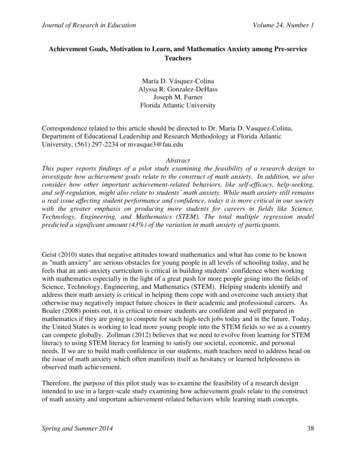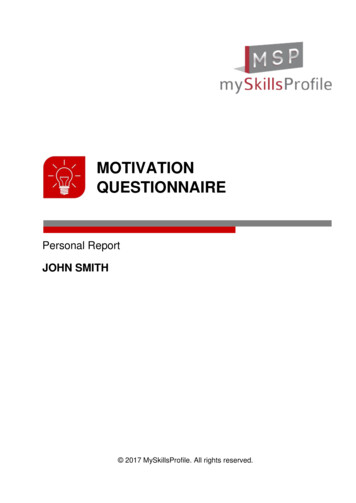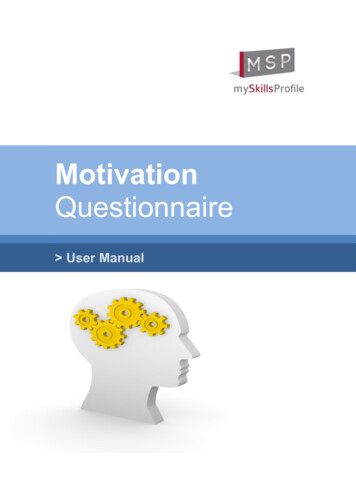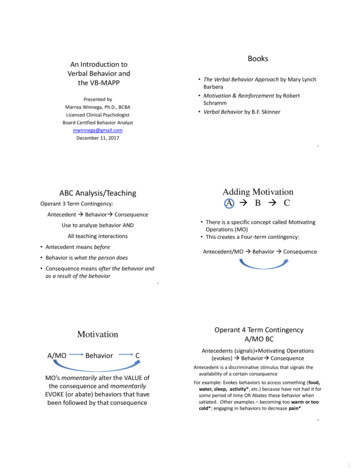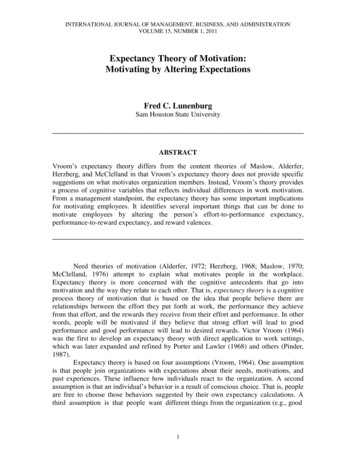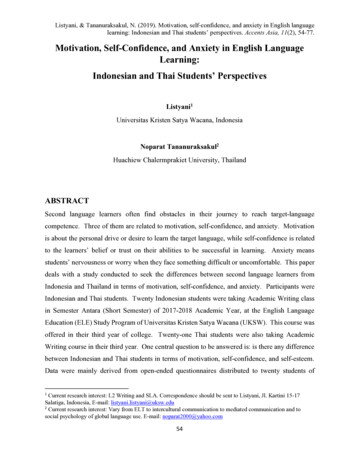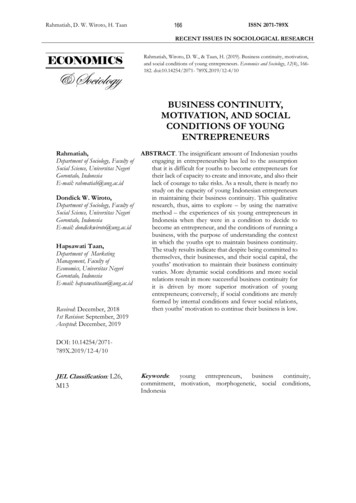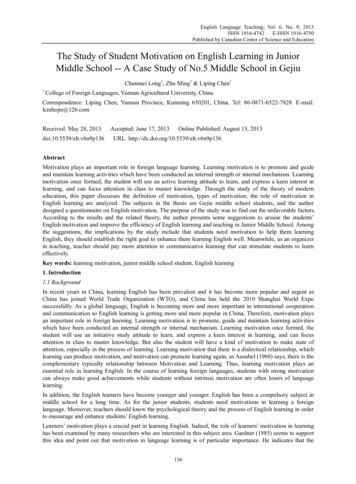
Transcription
English Language Teaching; Vol. 6, No. 9; 2013ISSN 1916-4742E-ISSN 1916-4750Published by Canadian Center of Science and EducationThe Study of Student Motivation on English Learning in JuniorMiddle School -- A Case Study of No.5 Middle School in GejiuChunmei Long1, Zhu Ming1 & Liping Chen11College of Foreign Languages, Yunnan Agricultural University, ChinaCorrespondence: Liping Chen, Yunnan Province, Kunming 650201, China. Tel: 86-0871-6522-7828. E-mail:lcmhope@126.comReceived: May 28, 2013doi:10.5539/elt.v6n9p136Accepted: June 17, 2013Online Published: August 15, 2013URL: vation plays an important role in foreign language learning. Learning motivation is to promote and guideand maintain learning activities which have been conducted an internal strength or internal mechanism. Learningmotivation once formed, the student will use an active learning attitude to learn, and express a keen interest inlearning, and can focus attention in class to master knowledge. Through the study of the theory of moderneducation, this paper discusses the definition of motivation, types of motivation; the role of motivation inEnglish learning are analyzed. The subjects in the thesis are Gejiu middle school students, and the authordesigned a questionnaire on English motivation. The purpose of the study was to find out the unfavorable factors.According to the results and the related theory, the author presents some suggestions to arouse the students’English motivation and improve the efficiency of English learning and teaching in Junior Middle School. Amongthe suggestions, the implications by the study include that students need motivation to help them learningEnglish, they should establish the right goal to enhance them learning English well. Meanwhile, as an organizerin teaching, teacher should pay more attention to communicative learning that can stimulate students to learneffectively.Key words: learning motivation, junior middle school student, English learning1. Introduction1.1 BackgroundIn recent years in China, learning English has been prevalent and it has become more popular and urgent asChina has joined World Trade Organization (WTO), and China has held the 2010 Shanghai World Exposuccessfully. As a global language, English is becoming more and more important in international cooperationand communication so English learning is getting more and more popular in China. Therefore, motivation playsan important role in foreign learning. Learning motivation is to promote, guide and maintain learning activitieswhich have been conducted an internal strength or internal mechanism. Learning motivation once formed, thestudent will use an initiative study attitude to learn, and express a keen interest in learning, and can focusattention in class to master knowledge. But also the student will have a kind of motivation to make state ofattention, especially in the process of learning. Learning motivation that there is a dialectical relationship, whichlearning can produce motivation, and motivation can promote learning again, as Ausubel (1968) says, there is thecomplementary typically relationship between Motivation and Learning. Thus, learning motivation plays anessential role in learning English. In the course of learning foreign languages, students with strong motivationcan always make good achievements while students without intrinsic motivation are often losers of languagelearning.In addition, the English learners have become younger and younger. English has been a compulsory subject inmiddle school for a long time. As for the junior students, students need motivations in learning a foreignlanguage. Moreover, teachers should know the psychological theory and the process of English learning in orderto encourage and enhance students’ English learning.Learners’ motivation plays a crucial part in learning English. Indeed, the role of learners’ motivation in learninghas been examined by many researchers who are interested in this subject area. Gardner (1985) seems to supportthis idea and point out that motivation in language learning is of particular importance. He indicates that the136
www.ccsenet.org/eltEnglish Language TeachingVol. 6, No. 9; 2013motivation of foreign language learning contains four aspects: a goal, effortful behavior, a desire to attain thegoal and attitude. Students who have strong learning motivation take a correct and positive attitude towardsstudy and make great efforts to master English with clear goal and desire and consequently gain better grade. Itis true that motivation is such a basic factor in language learning that no teacher could avoid being concernedwith students’ motivation. Therefore, teachers and students also pay more attention to motivation, which candrive students to learn English actively.1.2 Problem Statement and Research QuestionsLearners’ motivation of learning a language is considered as a crucial factor influencing the achievement andproficiency of learning. If a student is given motivation, student can learn a language better and can last thelearning enthusiasm longer. Without motivation nobody can achieve the long-term goal of learning a language.High achievement-motivation is one of factors that cause successful learning may cause high motivation as well.Foreign language teachers want to stimulate students’ learning motivation very much. How do we promotestudents’ motivation in learning English? So we should have a general understanding of learning motivation inorder to understand students to learn behaviors comprehensively.1.3 Factors of the Junior Students and the TeachersFor students, firstly of all, the junior students are not perfect mentally. The world view, the outlook on life andvalues are relatively immature. Second, the junior students have strong self-esteem, and sometimes they have alittle reverse psychology to the family and school education so that motivation education has enormous obstacles.Third, the different students have the different experience and personalities so that the methods of motivationeducation should be different. Then the motivation education for the junior students is doomed to need a greatwork. In the methods of research, there is a large number of explorative works to be completed.For teachers, the primary reason is that teachers do not pay sufficient attention to ideology. Some teacherssuppose that it is a waste of time to cultivate motivation for students. Another reason can be that teachers havesome misunderstandings. They think that the primary school when everyone has been so motivated to learned forlife should be the phase for students to cultivate motivation, while sometimes the junior students have been fixedand then it is in vain to cultivate motivation for them.The junior students have the initial psychological basis to carry out their ideals to the end and obtain thecorresponding ability to reserve. It is the key and transitional period from the unconscious motivation toself-motivation. If the students can grasp this period well, they will be excellent and successful. Instead, they willgo into the opposite way. The instability of the junior students’ learning is the reflection of the amount ofmotivation. That is why we must seize the opportunity to guide students in forming a clear and sustainedmotivation. Motivation is the internal cause and the external cause functions owing to the internal cause, so theteachers’ guidance should be natural, but strongly imposed on students.2. Literature Review2.1 Studies on Learning Motivation Abroad and HomeMotivation has been considered as one of important factors influencing the success of second language learning.About its definition different scholars hold different ideas, form different perspectives. Gardner (1985) definesmotivation as the combination of effort plus desire to achieve the goal of learning the language plus favorableattitudes towards learning the language. This definition includes three components: (1) effort expanded to reachthe goal; (2) desire to achieve the goal; (3) favorable attitude towards learning language. “Motivation is a forcethat energizes, sustains, and directs behavior toward a goal” (Paul Eggen&Kauchak Don, 2005:349).Some researchers emphasize that goal is a part of motivation. Wen Qiufang (1996) thinks of motivation simplyas reasons and goals of learning English. He Zhaoxiong and Mei Deming (1999) define motivation as thelearner’s overall goal or orientation. Johnstone (1999) considers that motivation is a drive directed towards agoal. Pintrich and Schunk (2002:4) think of motivation as “the process whereby goal directed activity isinstigated and sustained”, in which motivation is to start and keep the activity towards the goal. Williams andBurden(1997)interpreted motivation as a state of cognitive and emotional arousal, which leads to a consciousdecision to act, and which gives rise to a period of sustained intellectual and/or physical effort in order to attain apreviously set goal. Some of them are learners’ internal factors, such as interest, curiosity, or a wish to succeed.Others are external, such as the influence of the learning contexts, the learning situation and the influence ofother people. This internal-external distinction has played a significant role in many theories of motivation.Gardner (1972) defines integrative reasons as those that indicate an interest in learning the language in order tomeet and communicate with members of the second language community. Instrumental reasons refer to those137
www.ccsenet.org/eltEnglish Language TeachingVol. 6, No. 9; 2013reasons, which stress the pragmatic aspects of learning the second language, without any particular interest incommunicating with the second language community (Gardner Macintyre, 1992). As Crookes and Schmidt(1991; 1996) defined, motivation is the learner’s orientation with regard to the goal of learning a secondlanguage. Students develop a motivation to learn; they initiate learning activities, stay involved in a learning taskand exhibit a commitment to learning.In the last two decades, quite a few Chinese scholars have also studied motivation and carried out someresearches among Chinese students. The researches contribute to motivation studies. They finds that learningmotivation is closely related to learning confidence, and that motivation and confidence are related to learningstrategies. They also investigated learning motivation among French majors, aiming to make clear therelationship between motivation and other factors. Wen Qiufang (2001) reports a study on developmentalpatterns of modifiable learner variables and their relations based on the questionnaire data. The research resultsindicate that the relations among the variables such motivation, beliefs and strategies are fairly stable. Hao Meiand Hao Ruoping (2001) all research the relationship between English achievement and achievement motivationas well as anxiety state. Wu Heping (2001) and Wen Qiufang (2001) study the internal structure of EFLmotivation, and concluded the relationship between motivation and causal attribution, interest in Englishself-efficacy, the learning purpose, goal orientations and efforts. The research on motivation is essential toteachers. If teachers do not understand students’ foreign language learning motivation, then it is very difficult forthem to complete foreign language teaching tasks outstandingly. How do we arouse and keep middle schoolstudents’ learning motivation? Some teachers think that to give students proper reward; some teachers think thatthe entrance examination plays an important role in students’ learning motivation and it is important to givestudents proper reward.2.2 Main Types of MotivationGardner and Lambert (1959) made the well-known distinction between integrative orientations and instrumentalorientations in motivation. Instrumental motivation is generally characterized by the desire to obtain somethingpractical or concrete from the study of a second language (Hudson, 2000). Integrative motivation is characterizedby the learner’s positive attitudes towards the target language group and comes into play when one desires tobecome a part of a community that uses the target language in social situations.The intrinsic/extrinsic distinction has been influential in studies of motivation, and these concepts have beenused in various attempts to explain differences in motivation among different learners. An intrinsically motivatedstudent learns because he or she wants to learn. “Intrinsic motivation is the motivation to be involved in anactivity for its own sake” (Paul Eggen&Kauchak Don, 2005:398). VanLier (1996) defines intrinsic motivation interms of drive theories: certain basic psychological needs which are innate in the human being. It is important tonote that it is intrinsic motivation that is engendered by the learning process itself. Those views are encouragingto language teachers, owing to the fact that some students bring no intrinsic motivation to the classroom. As thelanguage “teachers, our task is to maximize the stimulation of students” intrinsic motivation, while extrinsicmotivation can be used to marshal the productive forces of intrinsic motivation. “Extrinsic motivation is astanding invitation to students to adopt a surface approach.”(Biggs, 2002:61). The students focus on theirperformance and the value or the importance that they attach to the outcome. “Extrinsic motivation ischaracterized as the motivation to engage in an activity as a means to an end.”(Paul Eggen&Kauchak Don,2005:349). An extrinsically motivated student performs in order to receive a reward, such as graduating orpassing a test or avoiding a penalty like a failing grade. Extrinsic motivation is stimulated not by the processitself but by what can be got from doing the action. At the same time, the junior middle school students’ learningmotivation are influenced by the intrinsic motivation and extrinsic motivation, but extrinsic motivation affectmainly. The dominated intrinsic motivation including curiosity, thirst for knowledge, interest and competition etc;the dominated extrinsic motivation including current incentives, strengthening attract, desperate for peerrecognition and admiration. (An Min, 2010)2.3 Theories of Learning MotivationThere are several theories of learning motivation. Different scholars clarify motivation into different categories.Bandura (1986) defined self-efficacy as individuals’ confidence in their abilities to organize mad execute a givencourse of action to solve a problem or accomplish a task. Attribution theory suggests that the elements, to whicha person attributes his successes and failures, influence his expectations for future success and hence affectmotivations. Atkinson(1964) developed motivation theories which were based on the following formula:Motivation (M) Perceived probability of Success (Ps) x Incentive value of success (Is) Locke & Latham(1990)put forward the Goal-setting theory, holding that the individual’s behavior is decided by its goal, the individual138
www.ccsenet.org/eltEnglish Language TeachingVol. 6, No. 9; 2013will have a choice to settle goal, and effort for it before taking action.The teachers’ encouragement is also an important factor to influence goal-setting and goal-commitment. If astudent lacks self-confidence, the teacher’s encouragement will help the student realize his own ability oradvantage, which will motivate the student to set a goal. Therefore, each individual should set goals that canchallenge difficulties; however, they should not beyond their capabilities. Teachers should give rewards tostudents to increase students’ self-efficacy for obtaining the goal, and help students set clear, reasonable goalsbecause goals serve to motivate behavior. Students are more likely to work towards clear, specific, moderatelydifficult goals, because they perceive them as challenging but attainable. So teachers should master someimportant implications from the above goal-based theories, and establish proper goals for students and encouragethem to focus on learning improving.Learning motivation has three basic functions (Wu xinchun, 1999): (1) Stimulating function. Once learners havecertain learning motivation, in a certain condition, this incentive will stimulate learners to learn activities. (2)Pointing to the function. Learning motivation can make learners for certain learning objectives and learning. (3)Maintaining and regulating function. When learning activities, keep this active learning motivation will forcertain learning goals. And adjust the learning of the intensity and duration. Each individual realize learninggoals, and motivate to pursue the current learning activities, and to achieve our learning goals. Learningmotivation can drive the organism to maintain or strengthen learning activities, or conversion activity directionin order to achieve the ultimate goal.(Yao xiaoting&Mao lingling, 2010: Huang Qian, 2012). Therefore,motivation can help students to improve themselves, the study with questionnaire, which is necessary to researchthe student’s English learning motivation.3. Research Design3.1 Objectives and Research QuestionsThe study was conducted to measure some social and psychological variables affecting students’ Englishlearning. The variables discussed in this paper are students’ interest in English, attitudes to English-speakingpeople, integrative, instrumental, motivational intensity, students’ goals, parental encouragement and differentattributions. To measure these variables, I modified some questions to constitute my questionnaire(see theappendix). I translated these questions into Chinese because I did not want students to have comprehensiondifficulties in the way of the measurement procedure 45students from No.5 Middle School of Gejiu wasencouraged to answer the questions as honestly as possible in order to promote the validity of the responses. Iwant to find out that is motivation related to students’ grades. Namely, I want to find out the answers to thefollowing questions:1. Whether or not students’ interest in English affects their learning motivation and achievements?2. What are the main factors affecting students learning English?3.2 SubjectsThe subjects in this study were 45 junior middle school students from NO.5 Middle School of Gejiu. Most ofthem came from the countryside and boys were more than girls. There are 21girls and 24 boys. Their ages rangedfrom 13 to15 and most of them were 14. They started learning English in primary school. They are in GradeEight. I divided the students into two groups according to the marks of the Gejiu Final Examination last term:Group One is the middle level students (22), Group Two is the other students (23). In addition, all of them weremy students which may make them respond the questionnaire cautiously and responsibly. Considering the aboveaspects, on the whole, the subjects may represent the average middle school students in this school.3.3 InstrumentsThis research adopts a questionnaire. Questionnaire for students is used to express and verify the researchquestions. One of the purposes of the study is to identify student motivation. In this circumstance, questionnaireis the most appropriate way to get data. In addition, in questionnaire students need not sign their names and shystudents can also show their ideas without any embarrassment, which is possible to get the true data.3.4 Data CollectionThe questionnaire was taken during regular class time by the author. Before the students answered the questions,some necessary instructions had been given on what the aim of the questionnaire was and how to answer thequestionnaire and so forth by the author so that all the students can accomplish the questions with the rightattitude and right ways. They were required to answer the questions honestly and accurately by themselves. Theauthor explained that they need not write down their names on the questionnaire and all their information would139
www.ccsenet.org/eltEnglish Language TeachingVol. 6, No. 9; 2013be kept as secret.After the data were collected, they were carefully examined once more to guarantee that all of them are valid forstudy. Because of the authors’ knowledge limitation in statistics, all the data was analyzed by EXCEL.4. Data Collection and Analysis4.1 Results and AnalysisThe author collected and analyzed those 45 valid questionnaire accomplished by 45 students in Gejiu NO.5Junior Middle School. For the questionnaire, from the question 1 to 8, 8 questions which are showed on thefollowing table.Proportion Results of question 1-8706050abcde40302010012345678Questions Figure 1.It is obvious in the chart as the second question that illustrate 60% participants spent half an hour to learnEnglish in their daily life; but only 3.3% of them spend more than one hour to learn English. When it comes tostudents’ motivation, 46.7% students are sometimes internal motivation learning in their daily life. And 40%students can learn by themselves spontaneously. The sixth question shows that 56.7% students are no feelingabout learning English. According to the eighth question, 36.7% shows that goal-setting is the main factor ofstudents’ motivation in learning English. 23.3% students can strive for the learning goal. From the seventhquestion, 50% students expect to communicate with other in English. Most students consider that they expect toget high grade in learning English, which contains 36.7%. And, the first question and the fourth question showthat the most students are the middle level in the class, which 43.3% are confidence about learning English well.Some students think that they have some confidences to learn English well. The third questions shows that53.3% students believe the importance of learning English, 36.7% students think that learning English is moreimportant. The sixth question indicates that 56.7% students are unconsciousness about learning English.Table 1. Results of the ninth questionItem aItem bItem cItem dItem eItem fItem gItem hItem i66.7%40%23.3%36.7%16.7%16.7%23.3%3%0For the ninth question, 66.7% shows that most students’ learning motivation is the main source of take good140
www.ccsenet.org/eltEnglish Language TeachingVol. 6, No. 9; 2013result in the examination. The other main sources of learning motivation are 40% students get/avoid parents andteacher of praise/punishment, 23.3% students consider that English is interesting, 36.7% students want to goabroad or to find good job in the future, and 20% students have their own opinions.Table 2. Results of the tenth questionItem aItem bItem cItem dItem e46.7%16.7%40%13.3%0The tenth question, students achievement, 46.7% indicates that the teacher should teach well, they create arelaxed and happy atmosphere so student can learn English well. And 40% are parents and teachers paying moreattention on students’ learning English.Table 3. Results of the eleventh questionItem aItem bItem cItem dItem e66.7%40%23.3%36.7%0The eleventh question, 66.7% tells us that learning is not good, because the English class is boring, and 40% forstudents’ laziness, and 36.7% for lacking of English environment.For the twelfth question, students give teachers lots of advice; the most important is effective classroomatmosphere. And students interest in English songs that they learn from the song lyrics. The teacher can have aflexible and effective method to help students learning English. The teachers can tell stories about English orforeign fairy tale. And the teacher also can give students more time for active discussion and practice English.4.2 Discussions of the ResultsAccording to the survey, most students have a relatively clear study motivation. Students can realize theimportance of learning English. Students think that learning motivation is the main sources to get good grades inthe examination; some students get/avoid parents and teacher of praise/punishment; to go abroad or to find goodjob in the future; the role of learning is to improve their own quality. Those can answer the second question. Andthose also are the students’ interest in English affects their learning motivation and achievements. The JuniorMiddle school students’ English learning motivation level is not high, on the whole are largely instrumentalmotivation. It is a long-term “exam-oriented education system” that forces the English teaching should keep aneye on the test scores, yet “high score low-intelligence phenomenon universal existence”. To cope with theexamination, teachers teach students problem solving skills, students practice problem solving skills, studentsfocus almost entirely on how to deal with the test. Therefore, we should pay attention to training and inductionthe students’ intrinsic motivation of English learning for middle school students. And to improve middle schoolstudents' English learning initiative and self-consciousness. Students’ interest plays an important part in Englishlearning. Their interest in English affects their English learning and achievements. If students show great interestin English, they will hold positive attitudes towards English-speaking people and towards learning English.Therefore, teachers should take any possible measures to arouse student’s curiosity and develop their interest inEnglish learning.According to the analysis, we can see that motivation is very essential in students’ learning English in juniormiddle school. The methods to excite students’ English learning motivation are necessary.5. Some Suggestions to Students and Teachers5.1 Suggestions to the StudentsFor students, the students who use a variety of ways and activities can promote learning English. The studentsshould believe that they need motivation to help them learning English. Setting up the right self-concept andclear and concrete study goal play an important role. The learning goal is clear that the goal can encouragepeople to struggle for it, unremitting, insist on reaching the purpose.(1) Students set right goal in English learning. Zhan Lu (2012) put forward that the clear goal of study and the141
www.ccsenet.org/eltEnglish Language TeachingVol. 6, No. 9; 2013stage for students help them to realize goal one by one. The goal is students’ striving direction, and the standardappraised and sign improved in study. To make students fully realize the value of English learning. Establishingthe goal of learning English, and develop strong interest in learning English.(2) Students establish self-confidence. The students cultivate self-confidence and focuses on training themselvesto ask questions, find problems, the ability to solve the problem. And the students can think seriously andactively answer questions, guide the students’ divergent thinking and innovative consciousness.(3) Students take part in activity groups. In English classroom, the students should pay attention to join groupactivities. And the students launch the activity; they can have more opportunity to learn English.(4) Students developing strong interest in learning English. Interest is one of the important conditions of learningEnglish. Only the students who are determined to learn English well can generate strong interest in learning, sothey will be happy and efficient to learn English and obtain good effect of learning English.(5) Students master study method and form good learning habits. The correct learning methods and skills inEnglish learning is an important guarantee of the best effect. In addition, a good habit can help studentseffectively learning. Students in learning English should pay attention to develop spoken English, autonomouslearning English and good writing habits.5.2 Suggestions to the TeachersFor teacher, as an organizer or leader in teaching, teachers have responsibilities to increase their students’inclination to perform willingly and actively in English learning. As the old saying goes: “In ancient times thosewho wanted to learn would seek out a teacher, one who could propagate the doctrine, impart professionalknowledge, and resolve doubts.” Meanwhile, teacher should establish good teacher-student relationship withstudents. Teacher's role can be from focus knowledge to changes in the development of students. (Wu Baoming,2009)At the same time, it is proved that teacher could expound every creation purpose, meaning of knowledge amongclassroom instruction to test, make students realize the obvious value of knowledge and the knowledge canattract students to yield the prospective future and try their best to achieve it. So the English teacher should try toimprove the charm of English, improve the temptation of learning English as well, and help students to fullyrealize the importance of English.(1) Teacher should use various and interesting activities in whole class, in small groups or in pair, which canattract students’ attention.(2) Apply new and effective techniques--multi-media, e-learning, not only in print but also audio and visual thatarouses students’ curiosity and interest and also promote their intrinsic motivation. Adopting cooperativeactivities that can keep students feel safe and can stimulate their emotion.(3) Teacher should create a harmonious and co-operative classroom atmosphere to lighten students’ anxiety.Creating a student-centered environment is important, but not enough. A good class climate is vital to the successof the student-centered method.(4) Effective teaching and classroom management are relative (Huang Qian, 2012). Teachers can not only perfectin English but also good at managing the students. It is well know “Interest is the best teacher”. In the classroomteachers must be good at arousing students’ learning motivation and interests, enhancing their consciousness ofparticipation in classroom activities, especially, stimulating students’ interest in learning English and makingthem “happ
drive students to learn English actively. 1.2 Problem Statement and Research Questions Learners’ motivation of learning a language is considered as a crucial factor influencing the achievement and proficiency of learning. If a student is given motivation, student can learn a lan

